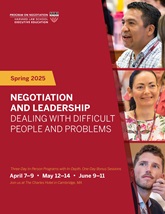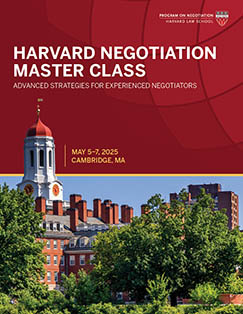
Whether at the local, federal, or international level, negotiations with governments often involve unique pressures and constraints. Does the official at the table actually have decision-making authority? What kinds of regulatory or policy constraints are they operating under? Governments often pursue very different interests in negotiations from those of a private company. In Seven Secrets for Negotiating with Government, PON faculty and executive committee member Jeswald Salacuse addresses some of the key variables involved in negotiation with government, including the influence of bureaucracy and the perception of power on the government side of the negotiating table. According to Salacuse, a first and fundamental challenge for any person negotiating with a government is to understand those special powers, constraints, and interests, and to use them in shaping a winning strategy.
Moreover, negotiating as a government official often involves a significant amount of pre-negotiation work to make sure you have buy-in or support from all interested parties on your own side. It takes practice negotiating with governments to understand what their true underlying interests might be, especially when there is an information or power disparity. To help practice negotiating with governments, the Teaching Negotiation Resource Center (TNRC) has a variety of negotiation simulations dealing with policy issues at local, federal, and international levels.
Camp Lemonnier – Featured Governmental Negotiation Simulation
This two party, three hour, non-scoreable negotiation is between the U.S. Defense Attaché and the Djiboutian Deputy Minister of Foreign Affairs over the potential lease renewal for a key strategic military base: Camp Lemonnier. Camp Lemonnier is a United States Naval Expeditionary Base located in Djibouti and is the only permanent U.S. military base in Africa. Djibouti, bordering Somalia, Ethiopia, Eritrea, the Red Sea and the Gulf of Aden, has been home to Camp Lemonnier since the September 11, 2001 attacks prompted the United States to seek a temporary staging ground for U.S. Marines in the region. Since then, Camp Lemonnier has expanded to nearly 500 acres and is a base of unparalleled importance. Major lessons of this simulation include:
- The importance of understanding the BATNA of all parties in a negotiation.
- The impact of culture in negotiation.
- Process management and agenda setting.
- Principal-agent dynamics.
- Uncovering sources of power in negotiation.
Preview a Camp Lemonnier Teacher’s Package to learn more about this simulation.
Save Fairport: Planning for Social Cyber Defense of Critical Urban Infrastructure– Featured Governmental Negotiation Simulation
This eight-party, two-hour negotiation is over a recovery proposal for the City of Fairport. Cybersecurity for critical urban infrastructure is a major public safety issue for cities. Cyber-attacks can cause major physical damage, as well as sow chaos and undermine public faith in government. Cyber criminals constantly develop new types of malware, which may not be detectable by current anti-virus software. Developing updated response plans and long-term organizational strategies is key to assuring that critical infrastructure continues to operate.
Last week the City of Fairport suffered a debilitating ransomware attack focused on the city’s water system. In the absence of a structured response, the city discovered that they face a range of significant cybersecurity hazards. The Mayor, who is running for re-election, needs to act quickly to demonstrate that she is addressing the serious threats facing the city. The Mayor has convened a group of key stakeholders to formulate a policy strategy and a realistic budget. Major lessons of this simulation include:
- Distinguishing positions vs. interests,
- Managing public-private, civil society coalitions in multiparty negotiations,
- Planning in the face of significant uncertainties,
- Power dynamics in city-level negotiations.
Preview a Save Fairport Teacher’s Package to learn more about this simulation.
Negotiating with Another Federal Agency and Negotiating with the Ministry of Health – Featured Governmental Negotiation Simulation
These are two separate two-person, non-scorable negotiation simulations focused on efforts to combat HIV/AIDs. The first is a negotiation entitled Negotiating with Another Federal Agency between a Center for Disease Control (CDC) Technical Co-Chair and a USAID Technical Co-Chair. The second is entitled Negotiating with the Ministry of Health and is between a CDC Technical Co-Chair and the Minister of Health in Sabada, the host country. The focus is on cross-cultural and political perspectives on public health initiatives.
These simulations highlight the challenges faced by public health personnel when working with their political counterparts in host countries. The simulation is designed to help CDC-type personnel practice negotiation techniques in order to effectively collaborate with personnel from other US federal agencies and with government officials in a host country. The negotiation scenarios involve elements that CDC personnel often face in the field: ill-defined negotiating protocols, funding constraints, preference for evidence-based programming, inter-agency competition, tensions around headquarter authority, political considerations, time constraints, difficult personalities, and in particular, competing public health priorities. The simulation emphasizes the importance of preparation; in particular, thinking about one’s own interests before entering negotiations. The CDC and the US Agency for International Development (USAID) and are working with Sabada’s Ministry of Health to address the country’s significant HIV/AIDS challenge. Parties must come to agreement about 1) how the prevention and treatment funds will be shared between the two agencies, and 2) how to allocate $55 million among four HIV/AIDS relief programs in a limited timeframe. Preview a Negotiating with Another Federal Agency Teacher’s Package to learn more about both of these simulations.
For additional simulations negotiating with governments, check out our full list of governmental simulations here.
Also check out PON faculty and executive committee member Jeswald Salacuse‘s book Seven Secrets for Negotiating with Government: How to Deal with Local, State, National, or Foreign Governments–and Come Out Ahead for more information on how to address the key variables involved in negotiating with government.
______________________
Take your training to the next level with the TNRC
The Teaching Negotiation Resource Center offers a wide range of effective teaching materials, including
- Over 250 negotiation exercises and role-play simulations
- Critical case studies
- Enlightening periodicals
- More than 30 videos
- 100-plus books
TNRC negotiation exercises and teaching materials are designed for educational purposes. They are used in college classroom settings or corporate training settings; used by mediators and facilitators seeking to introduce their clients to a process or issue; and used by individuals who want to enhance their negotiation skills and knowledge.
Negotiation exercises and role-play simulations introduce participants to new negotiation and dispute resolution tools, techniques and strategies. Our videos, books, case studies, and periodicals are also a helpful way of introducing students to key concepts while addressing the theory and practice of negotiation.
Check out all that the TNRC has in store >>



